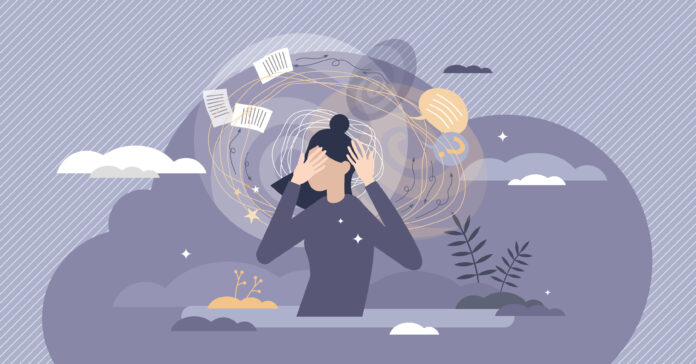Medical professionals often see patients exhibiting symptoms of more than one mental condition at a time, which are called comorbidities. However, the causes of these comorbidities involve delving into the complexity of the human brain and the myriad reasons why mental health conditions arise in the first place.
“Comorbidities are, unfortunately, common and a serious problem,” says Kristin Scaplen, an assistant neuroscience professor at Bryant University. “Research shows that the presence of comorbidity is associated with higher rates of suicidal ideations, more severe symptoms, and an overall poorer quality of life.”
Common Mental Health Comorbidities
Depression and anxiety are likely the most paired example in mental health comorbidities.
“According to the National Alliance on Mental Illness, approximately 60 percent of individuals suffering from depression show symptoms of anxiety and vice versa,” says Scaplen.
Scaplen adds that people suffering from depression and anxiety are also more likely to experience substance use disorders — at a rate of about 30 percent.
Scaplen cites three potential explanations for this. First is that the three conditions may share similar risk factors, meaning susceptibility to one could lead susceptibility to another. Secondly, those suffering with depression or anxiety could be using substances to try to cope with the symptoms, and, thirdly, the substance itself may be altering the brain and leaving it more prone to anxiety or depression.
Read More: How Caffeine and Alcohol Can Make Your Mental Health Worse
Developing Mental Health Conditions
“Behaviors are very complex, so we have to let go of the idea that there’s going to be some kind of one gene, one impact,” says Justin Kei, medical director of The Debra Simon Center for Integrative Behavioral Health and Wellness at Hackensack Meridian Health.
For example, in the case of schizophrenia, hundreds of risk genes for the disorder appear to each contribute to the mental disorder, notes Kei. However, it’s impossible to isolate one particular gene as being solely responsible for it. More research is needed there, Kei adds.
Environmental influences come into play as well. Keeping with the schizophrenia example, Kei says heavy marijuana use in adolescence is linked with a higher risk with the disorder.
Other outside impacts to mental health conditions include climate change, air pollution, substance use and diet.
“The gut has so many nerve cells and it has a direct connection to the brain in terms of nerves that supply it,” Kei says. “So, what we eat and essentially what is in our gut has a very direct relationship with our brain and thus our emotions and our thoughts.”
Stress experienced in our childhoods also has the potential to shape our brain and potentially lead to mental illness, notes Scaplen.
Read More: 5 Rare Mental Conditions You May Not Know About
Brain Processing for Mental Health Conditions
So, what is happening in the brain? For patients diagnosed with anxiety, there is often extra activity in the limbic system — the portion of the brain where emotions are processed — explains Scaplen.
“Mental disorders are characterized by a variety of disruptions to pathways within the brain and the neurotransmitters it uses for communication,” says Scaplen. “The specific disruptions depend on the disorder.”
Patients diagnosed with depression sometimes experience less activity in their frontal lobes. Meanwhile consuming alcohol can flood the reward circuitry in the brain of someone with a substance use disorder and make it difficult for these individuals to stop drinking.
Despite knowing about these physical brain differences in these disorders, it isn’t possible to diagnose these conditions by looking at the brain alone. Doctors still must rely heavily on a patient’s reporting of symptoms which are then matched against the current Diagnostic and Statistical Manual of Mental Disorders — a process Kei, refers to as an “outside in” approach.
In fact, Kei believes when and if technology improves enough that a diagnosis of a mental health disorder can be made through a simple brain scan or other similar measure, it may indicate that previously thought comorbidities actually weren’t comorbidities at all.
“I tell (my patients) don’t fixate so much on our diagnoses because these diagnoses could change as research changes,” Kei says. “It’s likely something more central is going on that is giving rise to different appearances.”
Read More: How Do Different Emotions Manifest In The Body?
Treatment for Multiple Mental Health Conditions
Mental health experts say depression and anxiety can sometimes be treated with the same medication — known as a selective serotonin reuptake inhibitor. Other times different treatments are needed to address the multiple conditions.
“Even the talk therapy techniques have some nuances and targeting that you would change based on the condition,” says Kei.
Scaplen says it’s beneficial to tackle the different disorders at once. “Research shows that particularly for someone suffering from co-occurring disorders like substance use and depression or anxiety, it is better to treat both disorders at the same time,” Scaplen notes.
Read More: How to Improve Your Mental Health
Article Sources
Our writers at Discovermagazine.com use peer-reviewed studies and high-quality sources for our articles, and our editors review for scientific accuracy and editorial standards. Review the sources used below for this article:
Source : Discovermagazine












